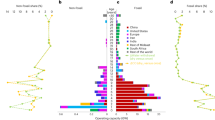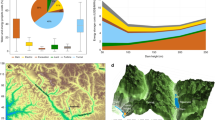Abstract
Thermoelectric generation requires large amounts of water for cooling. Recent warm periods have led to curtailments in generation, highlighting concerns about security of supply. Here we assess EU-wide climate impacts for 1,326 individual thermoelectric plants and 818 water basins in 2020 and 2030. We show that, despite policy goals and a decrease in electricity-related water withdrawal, the number of regions experiencing some reduction in power availability due to water stress rises from 47 basins to 54 basins between 2014 and 2030, with further plants planned for construction in stressed basins. We examine the reasons for these pressures by including water demand for other uses. The majority of vulnerable basins lie in the Mediterranean region, with further basins in France, Germany and Poland. We investigate four adaptations, finding that increased future seawater cooling eases some pressures. This highlights the need for an integrated, basin-level approach in energy and water policy.
This is a preview of subscription content, access via your institution
Access options
Access Nature and 54 other Nature Portfolio journals
Get Nature+, our best-value online-access subscription
$29.99 / 30 days
cancel any time
Subscribe to this journal
Receive 12 digital issues and online access to articles
$119.00 per year
only $9.92 per issue
Buy this article
- Purchase on Springer Link
- Instant access to full article PDF
Prices may be subject to local taxes which are calculated during checkout


Similar content being viewed by others
References
Water Use in Industry (Eurostat, 2014); http://ec.europa.eu/eurostat/statistics-explained/index.php/Water_use_in_industry
Koch, H. & Vögele, S. Dynamic modelling of water demand, water availability and adaptation strategies for power plants to global change. Ecol. Econ. 68, 2031–2039 (2009).
Proust, K. et al. Climate, Energy and Water; Accounting for the Links (Land and Water, 2007); http://s3.amazonaws.com/zanran_storage/www.crdc.com.au/ContentPages/44777431.pdf
Luck, M., Landis, M. & Gassert, F. Aqueduct Water Stress Projections: Decadal Projections of Water Supply and Demand Using CMIP5 GMs (World Resources Institute, 2015); https://www.wri.org/sites/default/files/aqueduct-water-stress-projections-technical-note.pdf
Holland, R. A. et al. Global impacts of energy demand on the freshwater resources of nations. Proc. Natl Acad. Sci. USA 112, E6707–E6716 (2015).
Russo, S., Dosio, A., Sterl, A., Barbosa, P. & Vogt, J. Projection of occurrence of extreme dry-wet years and seasons in Europe with stationary and nonstationary Standardized Precipitation Indices. J. Geophys. Res. 118, 7628–7639 (2013).
Scott, J. & Rajamani, L. EU climate change unilateralism. Eur. J. Int. Law 23, 469–494 (2012).
Limiting Global Climate Change to 2 Degrees Celsius—The way Ahead for 2020 and Beyond (Commission of the European Communities, 2007).
Byers, E. A., Hall, J. W., Amezaga, J. M., O’Donnell, G. M. & Leathard, A. Water and climate risks to power generation with carbon capture and storage. Environ. Res. Lett. 11, 024011 (2016).
Macknick, J., Newmark, R., Heath, G. & Hallett, K. C. Operational water consumption and withdrawal factors for electricity generating technologies: a review of existing literature. Environ. Res. Lett. 7, 045802 (2012).
Fricko, O. et al. Energy sector water use implications of a 2-degree climate policy. Environ. Res. Lett. 11, 034011 (2016).
Okadera, T., Chontanawat, J. & Gheewala, S. H. Water footprint for energy production and supply in Thailand. Energy 77, 49–56 (2014).
Pfister, S., Saner, D. & Koehler, A. The environmental relevance of freshwater consumption in global power production. Int. J. Life Cycle Assess. 16, 580–591 (2011).
Spang, E. S., Moomaw, W. R., Gallagher, K. S., Kirshen, P. H. & Marks, D. H. The water consumption of energy production: an international comparison. Environ. Res. Lett. 9, 105002 (2014).
Hejazi, M. I. et al. 21st century United States emissions mitigation could increase water stress more than the climate change it is mitigating. Proc. Natl Acad. Sci. USA 112, 10635–10640 (2015).
Van Vliet, M. T. H., Wiberg, D., Leduc, S. & Riahi, K. Power-generation system vulnerability and adaptation to changes in climate and water resources. Nat. Clim. Change 6, 375–380 (2016).
Database Description and Research Methodology UDI World Electric Power Plants Database. 1 (Platts, 2015); https://www.platts.com/im.platts.content/downloads/udi/wepp/descmeth.pdf
Gassert, F., Landis, M., Luck, M., Reig, P. & Shiao, T. Aqueduct Global Maps 2.1 (World Resources Institute, 2015); https://www.wri.org/sites/default/files/Aqueduct_Global_Maps_2.1.pdf
Hussey, K. & Pittock, J. The energy-water nexus: managing the links between energy and water for a sustainable future. Ecol. Soc. 17, 1–9 (2012).
Fais, B., Blesl, M., Fahl, U. & Voß, A. Comparing different support schemes for renewable electricity in the scope of an energy systems analysis. Appl. Energy 131, 479–489 (2014).
Behrens, P., Rodrigues, J., Brás, T. & Silva, C. Environmental, economic, and social impacts of feed-in tariffs: a Portuguese perspective 2000–2010. Appl. Energy 173, 309–319 (2016).
King, C. W., Stillwell, A. S., Twomey, K. M. & Webber, M. E. Coherence between water and energy policies. Nat. Resour. J. 53, 117–215 (2013).
Becker, S., Rodriguez, R. A., Andresen, G. B., Schramm, S. & Greiner, M. Transmission grid extensions during the build-up of a fully renewable pan-European electricity supply. Energy 64, 404–418 (2014).
Wu, M. & Chiu, Y. Consumptive Water Use in the Production of Ethanol and Petroleum Gasoline 2011 Update Report number ANL/ESD/09-1 (Argonne National Laboratory, 2011).
The Dublin Statement on Water and Sustainable Development 1–55 (World Meteorological Organization, 1992); http://www.wmo.int/pages/prog/hwrp/documents/english/icwedece.html.
Rijke, J., van Herk, S., Zevenbergen, C. & Ashley, R. Room for the river: delivering integrated river basin management in the Netherlands. Int. J. River Basin Manage. 10, 369–382 (2012).
Nielsen, H. Ø., Frederiksen, P., Saarikoski, H., Rytkönen, A.-M. & Pedersen, A. B. How different institutional arrangements promote integrated river basin management. Evidence from the Baltic Sea region. Land Use Policy 30, 437–445 (2013).
Linkov, I. et al. From comparative risk assessment to multi-criteria decision analysis and adaptive management: recent developments and applications. Environ. Int. 32, 1072–1093 (2006).
Pahl-Wostl, C., Lebel, L., Knieper, C. & Nikitina, E. From applying panaceas to mastering complexity: toward adaptive water governance in river basins. Environ. Sci. Policy 23, 24–34 (2012).
Pahl-Wostl, C. Transitions towards adaptive management of water facing climate and global change. Water Resour. Manag. 21, 49–62 (2007).
Mostert, E. et al. Social learning in European river-basin management: barriers and fostering mechanisms from 10 river basins. Ecol. Soc. 12, 19 (2007).
Collins, R., Kristensen, P. & Thyssen, N. Water Resources Across Europe—Confronting Water Scarcity and Drought EEA Report 2/2009. (Resilience Alliance, 2009); http://dx.doi.org/10.2800/16803
Meador, M. Inter-basin water transfer: ecological concerns. Fisheries 17, 17–22 (1992).
Capros, P., Mantzos, L., Papandreou, V. & Tasios, N. European Energy and Transport—Trends to 2030 1–158 (Directorate-General for Energy and Transport, 2007).
Electricity Production and Supply Statistics (European Commission, 2014); http://ec.europa.eu/eurostat/statistics-explained/index.php/Electricity_production_and_supply_statistics
CARMA Database v3.0 (Centre for Global Development, 2009); http://www.carma.org
Dams and Development: A New Framework for Decision-Making 58–63 (World Commission on Dams, 2001); http://pubs.iied.org/pdfs/9126IIED.pdf
Fthenakis, V. & Kim, H. C. Life-cycle uses of water in US electricity generation. Renew. Sustain. Energy Rev. 14, 2039–2048 (2010).
Elcock, D. Future US water consumption: the role of energy production. J. Am. Water Resour. Assoc. 46, 447–460 (2010).
Joint Research Centre. Analysis of Energy Saving Potentials in Energy Generation: Final Results (Institute for Energy and Transport at the European Commission, 2012); http://dx.doi.org/doi:10.2790/58574
MacLeay, I., Harris, K. & Annut, A. Digest of UK Energy Statistics 2013 1–268 (Department of Energy & Climate Change, National Statistics, 2013); https://www.gov.uk/government/uploads/system/uploads/attachment_data/file/279523/DUKES_2013_published_version.pdf
Moreno, F. & Martinez-Val, J. M. Collateral effects of renewable energies deployment in Spain: impact on thermal power plants performance and management. Energy Policy 39, 6561–6574 (2011).
Honoré, A. The Outlook for Natural Gas Demand in Europe (Oxford Institute for Energy Studies, 2014); https://www.oxfordenergy.org/wpcms/wp-content/uploads/2014/06/NG-87.pdf
Davis, S. J. & Socolow, H. Commitment accounting of CO2 emissions. Environ. Res. Lett. 9, 084018 (2014).
Schwarz, H. G. Modernisation of existing and new construction of power plants in Germany: results of an optimisation model. Energy Econ. 27, 113–137 (2005).
Rintamaa, R. & Aho-Mantila, I. Plant life management and modernisation: research challenges in the EU. Nucl. Eng. Des. 241, 3389–3394 (2011).
Venkatesh, A., Jaramillo, P., Griffin, W. M. & Matthews, H. S. Implications of near-term coal power plant retirement for SO2 and NOX and life cycle GHG emissions. Environ. Sci. Technol. 46, 9838–9845 (2012).
Collins, M. et al. in Climate Change 2013: The Physical Science Basis (eds Stocker, T. F. et al.) 1029–1136 (IPCC, Cambridge Univ. Press, 2013).
O’Neill, B. et al. A new scenario framework for climate change research: the concept of shared socioeconomic pathways. Climatic Change 122, 387–400 (2014).
Taylor, K. E., Stouffer, R. J. & Meehl, G. A. An overview of CMIP5 and the experiment design. Bull. Am. Meteorol. Soc. 93, 485–498 (2012).
Van Vuuren, D. P. et al. The use of scenarios as the basis for combined assessment of climate change mitigation and adaptation. Glob. Environ. Change 21, 575–591 (2011).
Macknick, J., Sattler, S., Averyt, K., Clemmer, S. & Rogers, J. The water implications of generating electricity: water use across the United States based on different electricity pathways through 2050. Environ. Res. Lett. 7, 045803 (2012).
Kelly, B. Nexant Parabolic Trough Solar Power Plant Systems Analysis Task 2: Comparison of Wet and Dry Rankine Cycle Heat Rejection (NREL, 2006); http://www.nrel.gov/docs/fy06osti/40163.pdf
Nomenclature of Territorial Units for Statistics (Eurostat 2017); http://ec.europa.eu/eurostat/web/nuts/overview
Gassert, F., Landis, M., Luck, M., Reig, P. & Shiao, T. Aqueduct Metadata Document Aqueduct Global Maps v.2. 0 1–20 (World Resources Institute, 2013).
Acknowledgements
We thank the World Resources Institute and R. Hofste for their support.
Author information
Authors and Affiliations
Contributions
P.B. designed the study and performed analysis. M.T.H.v.V. provided specific data and input on drafting. J.F.D.R. assisted with the analysis. T.N. assisted in preparing the data set of power plants. P.B. drafted the manuscript. All authors discussed the results and contributed to the manuscript.
Corresponding author
Ethics declarations
Competing interests
The authors declare no competing financial interests.
Supplementary information
Supplementary Information
Supplementary Figures 1–9, Supplementary Tables 1–14, Supplementary Notes 1–2 and Supplementary References (PDF 1155 kb)
Rights and permissions
About this article
Cite this article
Behrens, P., van Vliet, M., Nanninga, T. et al. Climate change and the vulnerability of electricity generation to water stress in the European Union. Nat Energy 2, 17114 (2017). https://doi.org/10.1038/nenergy.2017.114
Received:
Accepted:
Published:
DOI: https://doi.org/10.1038/nenergy.2017.114
This article is cited by
-
Extreme weather events on energy systems: a comprehensive review on impacts, mitigation, and adaptation measures
Sustainable Energy Research (2024)
-
Global assessment of the carbon–water tradeoff of dry cooling for thermal power generation
Nature Water (2023)
-
How Can the European Union Adapt to Climate Change?
Intereconomics (2022)
-
Identifying key processes and sectors in the interaction between climate and socio-economic systems: a review toward integrating Earth–human systems
Progress in Earth and Planetary Science (2021)
-
Global scenarios for significant water use reduction in thermal power plants based on cooling water demand estimation using satellite imagery
Nature Energy (2019)



